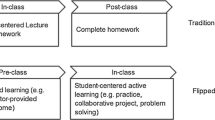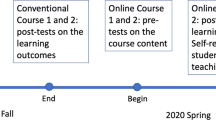Abstract
For this study the authors explored the use of pre-recorded lecture videos by students in a large introductory management course using a flipped classroom design to determine patterns of video use and to explore the potential relationship between student use of videos (video viewing) and student learning measured by grades and student satisfaction as measured by an end-of-course survey. A quantitative study approach was used, using frequency counts of student video use, student grades on three exams, and student responses to a 20-question survey. Correlation analysis results indicate that student use of videos varied significantly along several aspects – across the multiple video segments addressing a course topic, by time of day and day of week, and during the full course term. Implications for effective use of pre-recorded videos when implementing the flipped classroom model are discussed along with directions for much-needed future research.





Similar content being viewed by others
References
Albert, M. & Beatty, B. J. (2014). Flipping the classroom applications to curriculum redesign for an introduction to management course: impact on grades. Journal of Education for Business, 89(8), pp. 419–424.
Beatty, B. J. & Albert, M. (2016). Student perceptions of a flipped classroom management course. Journal of Applied Research in Higher Education, 8(3), pp. 1–16.
Bergman, J. (ed.) (2013). Flipping 2.0: Practical strategies for flipping your class. The Bretzmann Group.
Bergmann, J., & Sams, A. (2012). Flip the classroom. Washington, D.C.: International Society for Technology in Education.
Bishop, J. L. & Verlenger, M. A. (2013), The flipped classroom: A survey of the research, paper presented at the 120th ASEE Annual Conference & Exposition, Atlanta, Georgia, June 2013.
Bloom, B. S. (1956). Taxonomy of educational objectives, handbook I: The cognitive domain. New York: David McKay Co Inc.
Bonwell, C., and Eison, J. (1991). Active learning: Creating excitement in the classroom AEHE-ERIC Higher Education Report No. 1. Washington, D.C.: Jossey-Bass. ISBN 1-878380-08-7.
Chua, J., & Lateef, F. (2014). The flipped classroom: Viewpoints in Asian universities. Education in Medicine Journal, 6(4). doi:10.5959/eimj.v6i4.316
Enfield, J. (2013). Looking at the impact of the flipped classroom model of instruction on undergraduate multimedia students at CSU, Northridge. TechTrends, 57(6), 14–27.
Huba, M. E., & Freed, J. E. (2000). Learner-centered assessment on college campuses: Shifting the focus from teaching to learning. Boston: Allyn & Bacon.
Hughes, H. (2012). Introduction to flipping the college classroom. In T. Amiel & B. Wilson (EDs.), Proceedings from world conference on educational multimedia, hypermedia, and telecommunications. 2012 (p. 2434 – 2438). Chesapeake: AACE.
Karnad, A. (2013). Student use of recorded videos: A report reviewing recent research into the use of lecture capture technology in higher education, and its impact on teaching methods and attendance. London, UK: London School of Economics. Retrieved February 4, 2015, from http://eprints.lse.ac.uk/50929/1/Karnad_Student_use_recorded_2013_author.pdf
King, A. (1993). From sage on the stage to guide on the side. College Teaching, 41(1), 30–35. Retrieved January 18, 2014, from http://www.jstor.org/stable/27558571.
Lage, M. J., Platt, G. J., & Treglia, M. (2000). Inverting the classroom: A gateway to creating an inclusive learning environment. The Journal of Economic Education, 31(1), 30–43. http://doi.org/10.2307/1183338.
McNulty, J., Hoyt, A., Gruener, G., Chandrasekhar, A., Espiritu, B., et al. (2009). An analysis of lecture video utilization in undergraduate medical education: Associations with performance in the courses. BMC Medical Education, 9(1), 6.
Michael, J. (2006). Where's the evidence that active learning works? Advances in Physiology Education, 30(4), 159–167.
O’Flaherty, J., & Phillips, C. (2015). The use of flipped classrooms in higher education: A scoping review. The Internet and Higher Education, 2015(25), 85–95.
Phillips, R., Preston, G., Roberts, P., Cumming-Potvin, W., Herrington, J. Maor, D., Gosper, M. (2010). Using academic analytic tools to investigate studying behaviours in technology-supported learning environments. In Ascilite 2010. Sydney, pp. 761–771. Retrieved January 10, 2016, from http://echo360.com/sites/all/themes/echo360/files/Murdoch_Final%20Grant.pdf
Strayer, J. (2007). The effects of the classroom flip on the learning environment: a comparison of learning activity in a traditional classroom and a flip classroom that used an intelligent tutoring system. (Dissertation). Retrieved April 15, 2015, from https://etd.ohiolink.edu/
Strayer, J. (2012). How learning in an inverted classroom influences cooperation, innovation and task orientation. Learning Environments Research, 15(2), 171–193.
U.S. Department of Education. (2010). "Evaluation of Evidence-Based Practices in Online Learning: A Meta-analysis and Review of Online Learning Studies." Retrieved December 5, 2015, from www2.ed.gov/rschstat/eval/tech/evidence-based-practices/finalreport.pdf
Author information
Authors and Affiliations
Corresponding author
Rights and permissions
About this article
Cite this article
Beatty, B.J., Merchant, Z. & Albert, M. Analysis of Student Use of Video in a Flipped Classroom. TechTrends 63, 376–385 (2019). https://doi.org/10.1007/s11528-017-0169-1
Published:
Issue Date:
DOI: https://doi.org/10.1007/s11528-017-0169-1




